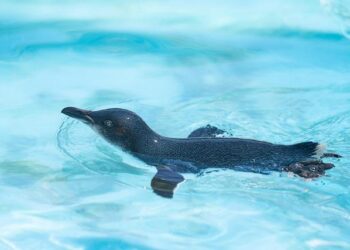
Clouded leopards (Neofelis nebulosa) have several adaptations that allow them to live in the tropical forests of southeast Asia. (Image credit: Shutterstock)
Name: Clouded leopard, also known as the mainland clouded leopard (Neofelis nebulosa)
Where it lives: Southeast Asia
What it eats: Mammals, including ungulates, primates and rodents
Why it’s awesome: Unlike lions and cheetahs in Africa, which stalk or race across the open plains in pursuit of prey, clouded leopards have a more arboreal approach to life, having adapted to living in the tropical forests of southeast Asia.
This tree-dwelling lifestyle has pushed them to possess remarkable ankles, which they can rotate by nearly 180 degrees.
Such incredible flexibility in these joints enables them to descend tree trunks headfirst. In captivity, these cats have been observed climbing upside down along horizontal branches and hanging down by their hind feet, enabling them to jump down onto prey below — although scientists believe they mainly hunt on the ground.
La pantera nebulosa es muy ágil en los árboles: puede desplazarse por las ramas cabeza abajo y descolgarse sujetándose por sus patas traseras. Sin embargo, prefiere cazar en tierra por las noches y usa los árboles para refugiarse en el día. Para saber más: https://t.co/l3ogZM51rb pic.twitter.com/DKdgr4EV5zNovember 10, 2023
See more
Clouded leopards have short, stocky legs, small bodies — between 27 and 42.5 inches (69 to 108 centimeters) long — and long tails, which are the longest of all cats relative to body size, and help them to balance in trees. They can weigh between 25 and 50 pounds (11 to 23 kilograms).
Clouded leopards also have the largest upper canines of all living cats, in proportion to their body size. A study published Oct. 6 in the journal Science Advances noted their teeth proportions are similar to some extinct sabertooth species.
Related: Cats’ dazzling eye colors may come from 1 unusual ancestor
When taking down large prey, these big cats don’t kill with a bite to the throat, unlike their large feline cousins. Instead, they bite the back of the neck to kill their prey, severing the spinal cord.
In 2006, researchers discovered that clouded leopards are actually two distinct species, with the now-named Sunda clouded leopards (N. diardi) endemic to the Sumatran and Bornean islands.
Both N. diardi and N. nebulosa are considered vulnerable by the International Union for Conservation of Nature (IUCN) Red List.
“The mainland clouded leopard lives in the dense forests across South and Southeast Asia showcasing remarkable adaptations for life in the tree tops,” Wai-Ming Wong, director of small cat conservation science for Panthera, the global wild cat conservation organization, told Live Science in an email.
“However, deforestation and agricultural expansion threatens much of the available habitat across their range. It is crucial to develop effective conservation management plans that include a range of stakeholders from local communities to government agencies to safeguard the future of this charismatic species,” Wong added.
Stay up to date on the latest science news by signing up for our Essentials newsletter.
Megan Shersby is a naturalist, wildlife writer and content creator. After graduating from Aberystwyth University with a BSc (Hons) degree in Animal Science, she has worked in nature communications and the conservation sector for a variety of organisations and charities, including BBC Wildlife magazine, the National Trust, two of the Wildlife Trusts and the Field Studies Council. She has bylines in the Seasons anthologies published by the Wildlife Trusts, Into The Red published by the BTO, and has written for the BBC Countryfile magazine and website, and produced podcast episodes for its award-winning podcast, The Plodcast.
>>> Read full article>>>
Copyright for syndicated content belongs to the linked Source : Live Science – https://www.livescience.com/animals/cats/clouded-leopard-the-cat-with-saber-like-teeth-that-can-walk-upside-down-in-trees































